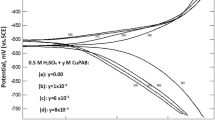Summary
Corrosion inhibition by quinine, ephedrine, brucine, cinchonine, codeine, and harmaline with respect to the dissolution of iron in 2M sulphuric acid was measured using electrochemical methods. Polarization curves indicated that these compounds act as mixed-type inhibitors,i.e. both the cathodic and anodic curves are affected. The observed effect follows theTemkin adsorption isotherm. The effect of the different structural features of these compounds on their inhibition efficiency has been studied. Results indicate that the rate of corrosion of iron increases with increasing temperature over the range 30–50 °C both in the absence and in the presence of inhibitors. Some thermodynamic functions were also computed and are discussed.
Zusammenfassung
Die von Chinin, Ephedrin, Brucin, Chinchonin, Codein und Harmalin ausgeübte Korrosionshemmung bei der Auflösung von Eisen in 2M Schwefelsäure wurde mittels elektrochemischer Methoden untersucht. Polarisationskurven zeigen, daß die erwähnten Verbindungen als Inhibitoren gemischten Typs fungieren, d. h. sowohl die kathodische als auch die anodische Kurve wurde beeinflußt. Der beobachtete Effekt folgt derTemkinschen Adsorptionsisotherme. Die Auswirkung von Strukturänderungen auf die Effizienz der Hemmung und einige thermodynamische Funktionen werden diskutiert. Die Korrosionstrate von Eisen steigt sowohl in Gegenwart als auch in Abwesenheit der Inhibitoren im Bereich von 30–50°C mit steigender Temperatur.
Similar content being viewed by others
References
Schmitt G., Bedbur K. (1984) Proc. 9th Int. Congr. Met. Corros. Toronto, Canada, p 112
Granese, S. L., Rosales, B. M., de Gonzalez C. O. (1989) Proc. 3rd Iberoamerican Congr. Corrosion and Protection, Rio de Janeiro, Brazil, p 1049
Granese S. L. (1987) Proc. 10th Int. Congr. Met. Corrosion, Madras, India, p 2733
Granese S. L., de Gonzalez, C. O., Rosales B. M. (1988) Quimindustria' 88, La Habana Cuba, p 176
Granese S. L. (1985) Proc. 6th European Symp. Corrosion Inhibitors, Ferrara Italy, p 227
Granese S. L. (1988) Corrosion44: 322
Gatos H. S. (1956) Corrosion12: 23
Donnelly B., Downie T. C., Grzeskoviak R., Hamburg, H. R., Short D. (1974) Corros. Sci.14: 597
Conway B. E. (1965) Theory and principles of electrode processes. The Ronald Press, New York, p 81
Khitrov V. A. (1960) Izv Voronezhsk, Gos. Ped. Inst.29: 5
Fouda A. S., Elasklany A. H., Madkour L. H. (1984) Indian J. Chem. Soc.61: 425
Author information
Authors and Affiliations
Rights and permissions
About this article
Cite this article
Al-Neami, K.K., Mohamed, A.K., Kenawy, I.M. et al. Inhibition of the corrosion of iron by oxygen and nitrogen containing compounds. Monatsh Chem 126, 369–376 (1995). https://doi.org/10.1007/BF00813198
Received:
Accepted:
Issue Date:
DOI: https://doi.org/10.1007/BF00813198




